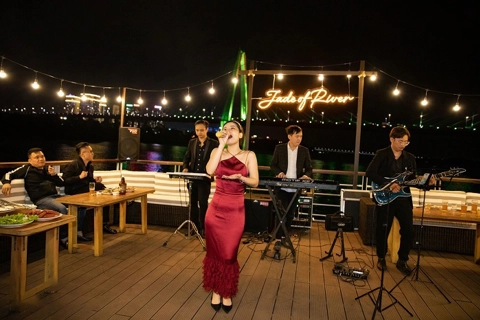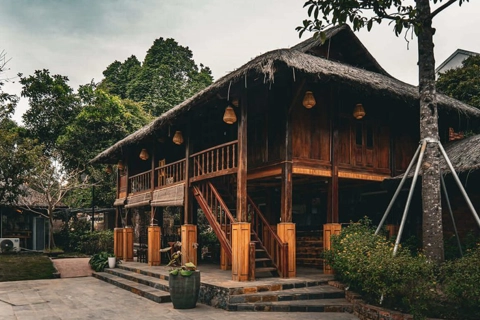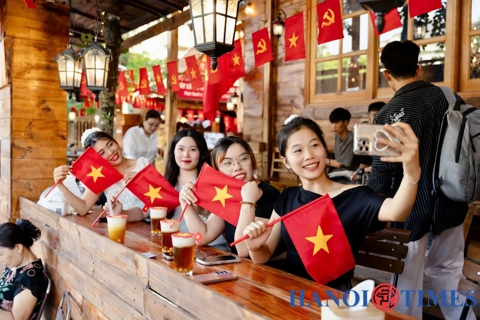Travel
What reasons behind policy making against Vietnam traditional fish sauce?
Mar 14, 2019 / 12:11 PM
"Nuoc mam" (fish sauce) is not only a traditional specialty, but also symbolizes Vietnamese culture that must be protected in any way.
Public indignation has stirred up after the Vietnamese Ministry of Agriculture and Rural Development (MARD) has issued a draft national standard set on production of nuoc mam (fish sauce) that is believed to trouble traditional fish sauce making craft and imply advocating industrial sauce with nuoc mam flavor.
The draft kit named TCVN-12607:2019 has a series of standards and requirements which are controversial, as follows:
Veterinary tests: Nguyen Quoc Hung, deputy director of Hanh Phuc Food Processing Company, told VnExpress that the requirement is unreasonable and costly as veterinary tests are mostly required for meat while nuoc mam is totally made from fish.
Histamine content: required below 400 parts per million (ppm) while craft nuoc mam, which is made in a traditional way, is made with only sea fish and salt would have the histamine level of 800-1,000 ppm. According a director of a food company in Phan Thiet city, known as a nuoc mam making hub, craft nuoc mam has high content of protein, therefore, the histamine level is high. He noted that the requirement is only suitable for industrial fish sauce which has little protein.
Microbiological control targets with Clostridium botulinum and Staphylococus aureus are clearly extravagant: These kinds are from meat, not fish and they are unable to exist in nuoc mam.
Bright tanks: It requires tanks containing nuoc mam must be bright while in reality nuoc mam has been stored in wood barrels, gourmet jars and cement tanks without any harm to the quality and food safety. The requirement somehow forces makers to invest more in facilities that will harm their profits and more importantly, modern facilities don’t mean the quality will be good.
Voices from insiders
Surprisingly, the draft document was made without consulting traditional nuoc mam craftsmen and the fish sauce guilds, according to Ho Kim Lien, head of the Phu Quoc Fish Sauce Association.
Huynh Quang Hung from the Phu Quoc Fish Sauce Association said that the traditional nuoc mam has lasted for centuries and it requires a specific standard set.
Echoing Hung, Pham Huynh Quoc Thanh, the owner of Kim Hoa nuoc mam brand, said that the draft is totally not suitable with the traditional method. Meanwhile, Nguyen Kim Chi, the owner of Thanh Khoa nuoc mam brand, said that having a common standard set for both traditional nuoc mam and industrial products is unreasonable and unfair.
However, Bui Nguyen Huy Hoang, director of Masan Phu Quoc Fish Sauce Company, supported the draft, saying that the standards follow international practices and are in line with Codex set.
Truong Quang Hien, head of the Phan Thiet Fish Sauce Association, said that Codex (CAC/RCF 52-2003) is mostly suitable with industrial products and so far, traditional nuoc mam makers have been protesting this set.
Long-lasting, famous, traditional product
Phu Quoc, the biggest island in Vietnam, is known for nuoc mam as the products made in this island have a distinct taste. Nuoc mam in Phu Quoc is made from anchovy and salt. The production has lasted for more than 200 years. Since the late of the 19th century, Phu Quoc’s people shipped nuoc mam to Cambodia and Thailand.
Experiencing hundred years, Phu Quoc is home to 53 makers, producing 25 million liters a year. Phu Quoc Nuoc Mam or Phu Quoc Fish Sauce has Geographical Indication recognized by the European Union (EU), making it the first Vietnamese product to obtain Protected Designation of Origin (PDO) protection in the territory of the 28 EU members.
Vietnam is home to dozens of famous nuoc mam production villages across the country from the northern city of Haiphong, the central provinces of Thanh Hoa, Nghe An, Ha Tinh, Ninh Thuan, Binh Thuan, Khanh Hoa, Phu Yen, Binh Dinh, Quang Nam, Quang Ngai, to the southern province of Kien Giang.
Questions remain
Nguyen Quoc Hung from Hanh Phuc Company said that the nuoc mam produced in traditional method requires a strict process of fishing raw materials to brewing, distilling, bottling, and consuming. Meanwhile, industrial products are easily to be made as if it is the last stage in the long production process.
But the two kinds of products are not clearly distinguished to ensure the quality and the protection of a century-long specialty that symbolizes Vietnamese culture, local experts raised voices.
With an aim to protect the traditional product, since early March, representatives from Vietnamese Traditional Fish Sauce Club, Association of Food Transparency, Business Association of High Quality Vietnamese Products, Ho Chi Minh City’s Food & Foodstuff Association (FFA), Fish Sauce Associations of Nha Trang, Phan Thiet, and Phu Quoc have lodged letters of complaint to Deputy Prime Minister Vu Duc Dam, Minister of Agriculture and Rural Development Nguyen Xuan Cuong, and Minister of Science and Technologies Chu Ngoc Anh requesting them to adjust the national standards for nuoc mam.
The complainers noted that the draft document has advocated the development of industrial products and deliberately troubled and more seriously harmed the traditional production.
Tran Thi Quoc Khanh, member of the National Assembly’s Committee for Science, Technologies, and Environment, demanded the categorization of traditional nuoc mam and industrial products be made. She raised concerns about some vested interests in deliberately equating the two kinds.
In terms of market share, Masan Group holds a 65% share of the industrial segment. The group’s Chairman Nguyen Dang Quang has been listed in the Vietnamese billionaire club in 2018 by Forbes, together with Vingroup Chairman Pham Nhat Vuong, who has been in the ranking for several yeas.

Nuoc mam - fish sauce. Illustrative photo
|
Veterinary tests: Nguyen Quoc Hung, deputy director of Hanh Phuc Food Processing Company, told VnExpress that the requirement is unreasonable and costly as veterinary tests are mostly required for meat while nuoc mam is totally made from fish.
Histamine content: required below 400 parts per million (ppm) while craft nuoc mam, which is made in a traditional way, is made with only sea fish and salt would have the histamine level of 800-1,000 ppm. According a director of a food company in Phan Thiet city, known as a nuoc mam making hub, craft nuoc mam has high content of protein, therefore, the histamine level is high. He noted that the requirement is only suitable for industrial fish sauce which has little protein.
Microbiological control targets with Clostridium botulinum and Staphylococus aureus are clearly extravagant: These kinds are from meat, not fish and they are unable to exist in nuoc mam.
Bright tanks: It requires tanks containing nuoc mam must be bright while in reality nuoc mam has been stored in wood barrels, gourmet jars and cement tanks without any harm to the quality and food safety. The requirement somehow forces makers to invest more in facilities that will harm their profits and more importantly, modern facilities don’t mean the quality will be good.
Voices from insiders
Surprisingly, the draft document was made without consulting traditional nuoc mam craftsmen and the fish sauce guilds, according to Ho Kim Lien, head of the Phu Quoc Fish Sauce Association.

Nuoc mam stored in wood barrels. Photo: Tadata
|
Echoing Hung, Pham Huynh Quoc Thanh, the owner of Kim Hoa nuoc mam brand, said that the draft is totally not suitable with the traditional method. Meanwhile, Nguyen Kim Chi, the owner of Thanh Khoa nuoc mam brand, said that having a common standard set for both traditional nuoc mam and industrial products is unreasonable and unfair.
However, Bui Nguyen Huy Hoang, director of Masan Phu Quoc Fish Sauce Company, supported the draft, saying that the standards follow international practices and are in line with Codex set.
Truong Quang Hien, head of the Phan Thiet Fish Sauce Association, said that Codex (CAC/RCF 52-2003) is mostly suitable with industrial products and so far, traditional nuoc mam makers have been protesting this set.
Long-lasting, famous, traditional product
Phu Quoc, the biggest island in Vietnam, is known for nuoc mam as the products made in this island have a distinct taste. Nuoc mam in Phu Quoc is made from anchovy and salt. The production has lasted for more than 200 years. Since the late of the 19th century, Phu Quoc’s people shipped nuoc mam to Cambodia and Thailand.
Experiencing hundred years, Phu Quoc is home to 53 makers, producing 25 million liters a year. Phu Quoc Nuoc Mam or Phu Quoc Fish Sauce has Geographical Indication recognized by the European Union (EU), making it the first Vietnamese product to obtain Protected Designation of Origin (PDO) protection in the territory of the 28 EU members.
Vietnam is home to dozens of famous nuoc mam production villages across the country from the northern city of Haiphong, the central provinces of Thanh Hoa, Nghe An, Ha Tinh, Ninh Thuan, Binh Thuan, Khanh Hoa, Phu Yen, Binh Dinh, Quang Nam, Quang Ngai, to the southern province of Kien Giang.

Anchovy - the main type of fish used to make traditional nuoc mam. Photo: Dreamstime
|
Nguyen Quoc Hung from Hanh Phuc Company said that the nuoc mam produced in traditional method requires a strict process of fishing raw materials to brewing, distilling, bottling, and consuming. Meanwhile, industrial products are easily to be made as if it is the last stage in the long production process.
But the two kinds of products are not clearly distinguished to ensure the quality and the protection of a century-long specialty that symbolizes Vietnamese culture, local experts raised voices.
With an aim to protect the traditional product, since early March, representatives from Vietnamese Traditional Fish Sauce Club, Association of Food Transparency, Business Association of High Quality Vietnamese Products, Ho Chi Minh City’s Food & Foodstuff Association (FFA), Fish Sauce Associations of Nha Trang, Phan Thiet, and Phu Quoc have lodged letters of complaint to Deputy Prime Minister Vu Duc Dam, Minister of Agriculture and Rural Development Nguyen Xuan Cuong, and Minister of Science and Technologies Chu Ngoc Anh requesting them to adjust the national standards for nuoc mam.
The complainers noted that the draft document has advocated the development of industrial products and deliberately troubled and more seriously harmed the traditional production.
Tran Thi Quoc Khanh, member of the National Assembly’s Committee for Science, Technologies, and Environment, demanded the categorization of traditional nuoc mam and industrial products be made. She raised concerns about some vested interests in deliberately equating the two kinds.
In terms of market share, Masan Group holds a 65% share of the industrial segment. The group’s Chairman Nguyen Dang Quang has been listed in the Vietnamese billionaire club in 2018 by Forbes, together with Vingroup Chairman Pham Nhat Vuong, who has been in the ranking for several yeas.








